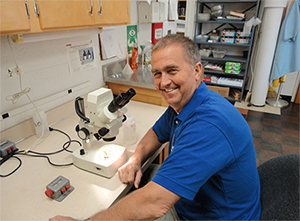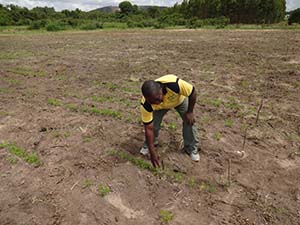Brandenburg explains value chain approach in southern Africa
By Christy Fricks
University of Georgia, Peanut & Mycotoxin Innovation Lab
Background
 Rick Brandenburg is Lead Scientist on PMIL’s Southern Africa Value Chain Interventions project and a collaborator on both the Ghana Peanut Value Chain Interventions and Haiti Peanut Value Chain Interventions projects. In addition to his work with PMIL, he is a Wm. Neal Reynolds Distinguished Professor and Co-Director of the Center for Turfgrass Environmental Research and Education at North Carolina State University
Rick Brandenburg is Lead Scientist on PMIL’s Southern Africa Value Chain Interventions project and a collaborator on both the Ghana Peanut Value Chain Interventions and Haiti Peanut Value Chain Interventions projects. In addition to his work with PMIL, he is a Wm. Neal Reynolds Distinguished Professor and Co-Director of the Center for Turfgrass Environmental Research and Education at North Carolina State University
PMIL: Would you give us an overview of the Southern Africa Value Chain and tell me a little about the value chain approach?
Dr. Brandenburg: "The first part of the team’s research is on plant health. A healthy plant is less likely to suffer from high levels of Aspergillus as compared to a stressed plant. That is a bit of a generalization, there are other factors as well, but that is the premise under which we operate. Also, a healthy plant can better fight off other stresses such as disease and a healthy plant will yield better. The second component of research is the post-harvest studies. This includes improving drying, storage, and processing--all of which can have significant impacts on aflatoxin levels.
Lastly, we are including socioeconomic studies to help us understand what incentives might exist that will encourage change in both pre- and post-harvest techniques. We are also looking at the marketing potential for peanuts with lower aflatoxin contamination.
All three components are critical to reducing aflatoxin contamination and none is higher than the other in overall importance. My focus remains consistent with my work at N.C. State University focusing on plant health through a partnership with my colleague and collaborator on this project, David Jordan. My other U.S. collaborators Koushik Adhikari, Manjeet Chinnan, Kumar Mallikarjunan, and Boris Bravo-Ureta cover the post-harvest and socioeconomic areas of this project.
In academia we often work in isolation, even those of us who work in integrated pest management. We still focus almost exclusively on plant health aspects and rarely pull in experts in other disciplines who might add novel perspectives. The PMIL Value Chain project in Southern Africa recognizes that the answers don’t lie just in the pre-harvest side of research, nor only in the post-harvest component and that incentives and sustainability as measured by socioeconomics are critical to effect change.
As we have made progress on the Southern Africa Value Chain project, I have become more engaged in the overall importance of this approach. We have come to accept the concept that aflatoxin management is not going to happen because of some ‘silver bullet’ or single intervention. But rather effective management will be the result of multiple interventions linked together in a logical, cost effective manner--one that is sustainable and provides incentives for growers.
Drs. Chinnan and Mwangwela in Lilongwe, Malawi with small scale processors during discussion of improving quality of peanut products."
PMIL: Managing all of the multiple parts of a value chain project seems very ambitious. How do you plan to measure outcomes from the research project?
Dr. Brandenburg: "Yes, the project is very ambitious. It has something like a dozen institutes and agencies, more than 30 scientists and students from 4 countries involved. We have also taken the time to build and maintain relationships with key organizations and entities in host countries that are uniquely positioned within the peanut value chain to offer insight and assistance. Examples of these groups in Malawi include: AfriNut, EXAGRIS, and Valid Nutrition. So there were a lot of logistical issues to sort through before we could even get the first research project initiated.
The overall breadth of the value chain project in southern Africa has offered a unique set of challenges as the program has begun its implementation. Despite the challenges, the scientists involved see the value in such an approach. Already I have observed dialogue between the pre- and post-harvest groups in the host countries regarding the means to take advantage of pre-harvest research trials to supply varying levels of contaminated peanuts for use in subsequent post-harvest research trials. These collaborations provide unique opportunities for conducting research trials in a timely and cost-effective manner that yield critical results.
Overall, we are confident that our research will provide insight into the continuum of aflatoxin reduction interventions and how they link together for a cumulative benefit."
PMIL: Your project focuses on three countries, Malawi, Zambia and Mozambique. Can you give me an overview of what is currently happening in each of those areas and the work they are doing?
 Dr. Brandenburg: "The pre-harvest research in all three countries maintains a focus on plant health.
Dr. Brandenburg: "The pre-harvest research in all three countries maintains a focus on plant health.
For the pre-harvest project I am collaborating closely with Sam Njoroge, legume pathologist at ICRISAT, Vincent Saka, Wezzi Mhango, and Trust Donga at LUANAR and starting to work with Justus Chintu at Chitedze Agricultural Research Station, all near Lilongwe. The pre-harvest work has expanded to include Alice Mweetwa at the University of Zambia in Lusaka, and Amade Muitia at IIAM in Nampula, Mozambique with projects underway in both countries."
PMIL: What role are graduate students playing in the project?
Dr. Brandenburg: "Graduate students are the key to achieving our research objectives and at the same time help us achieve our goal of capacity building for the long term. Each of our projects is led by a graduate student with supervision from our collaborating scientists and often participation from our international partners on their committees to approve their research design and make sure they are making progress.
In Zambia there are two students working with PMIL at the University of Zambia. A Ph.D. student, Hendrix Chalwe, is working on a model to forecast aflatoxin contamination levels in the field based upon soil type and rainfall and air temperature maximums in the 45 day period prior to harvest. He is taking a concept developed by Kira Bowen at Auburn University and applying her model for aflatoxin forecasts to Zambia (and southern Africa conditions). His thesis title is, “Modeling pre-harvest aflatoxin incidence in groundnuts using soil characteristics.”
We also have a master's student, Munsanda Ngulube, looking at the role of biochar as an amendment to the soil that may reduce field level aflatoxin contamination. The tentative title of the project is,”Biochar and Gypsum amendments for mitigating aflatoxin contamination in groundnuts.”
Another two students have been identified to work in the post-harvest (drying/storage) area and in the food science program to establish the baseline data.
In Mozambique, studies on the impact of planting and harvest dates on in field aflatoxin contamination were initiated last year. We have also identified a potential working group from Eduardo Mondlane University (UEM) and will be working to identify students to conduct research for the post-harvest objectives. We have six graduate students at LUANAR in Malawi: Chancy Sibakwe, researching biotic/abiotic stress impacts on pre-harvest aflatoxin contamination; Andrew Abraham, studying the effect of rotations and harvest dates on pre-harvest aflatoxin contamination; Clara Kasukula, measuring residual aflatoxin in oil from contaminated peanuts; Monica Chimbaza, reserching drying and storage technologies for reducing aflatoxin; Tchiyiwe Moyo, performing a baseline evaluation of peanut butter quality and processor knowledge of aflatoxin; and Chikondi Magiubu, working with processing and uses of peanut flour.
Published May 30, 2015
